Donate now to support the LLIFLE projects.
Your support is critical to our success.
Your support is critical to our success.
Gymnocalycium denudatum var. fleischerianum
Catalog name. Pubbl. in Bercht Catalogue 1992/93
Family: CACTACEAE
Catalog name. Pubbl. in Bercht Catalogue 1992/93
Family: CACTACEAE
Accepted Scientific Name: Gymnocalycium paraguayense f. fleischerianum (F.Haage) Mereg., D.Metzing & R.Kiesling
Candollea 57: 313 2002.

Gymnocalycium denudatum var. fleischerianum (Gymnocalycium paraguayense f. fleischerianum) Photo by: Alexander Arzberger
Synonyms:
- Gymnocalycium paraguayense f. fleischerianum (F.Haage) Mereg., D.Metzing & R.Kiesling
- Echinocactus denudatus f. scheidelianus (F.Haage) Schelle
- Gymnocalycium denudatum var. fleischerianum hort.
- Gymnocalycium fleischerianum Jajó ex Backeb. & F.M.Knuth
See all synonyms of Gymnocalycium paraguayense
back
Accepted name in llifle Database:Gymnocalycium paraguayense (Mundt) Schütz & Moser
Friciana VIII, no. 47: 3- 15 (1972); cf. Rowley in Repert. Pl. Succ. (I. O. S.). 23: 7 (1972 publ. 1974).
Synonymy: 29
- Gymnocalycium paraguayense (Mundt) Schütz & Moser
- Echinocactus denudatus var. paraguayensis Mundt
- Echinocactus paraguayensis K.Schum.
- Gymnocalycium denudatum var. paraguayense F.Haage ex Y.Itô
- Echinocactus denudatus var. anisitsii Frič
- Echinocactus denudatus var. bruennowianus F.Haage
- Echinocactus denudatus f. bruennowianus (F.Haage) Schelle
- Echinocactus denudatus var. brumorviana F.Haage
- Gymnocalycium denudatum var. delaetianum (F.Haage) Y.Itô
- Echinocactus denudatus var. delaetianus F.Haage
- Echinocactus denudatus f. delaetianus (F.Haage) Schelle
- Gymnocalycium denudatum var. golzianum (Mundt) Y.Itô
- Gymnocalycium paraguayense var. roseiflorum (Hildm. ex K.Schum.) Schuetz
- Echinocactus denudatus var. roseiflorus Hildm. ex K.Schum.
- Echinocactus denudatus f. roseiflorus (Hildm. ex K.Schum.) Schelle
- Gymnocalycium denudatum var. roseiflorum (Hildm. ex K.Schum.) Y.Itô
- Gymnocalycium paraguayense var. scheidelianum (F.Haage) Schuetz
- Echinocactus denudatus var. scheidelianus F.Haage
- Gymnocalycium denudatum var. scheidelianum (F.Haage) Y.Itô
- Gymnocalycium paraguayense var. wagnerianum (F.Haage) Schuetz
- Echinocactus denudatus var. wagnerianus F.Haage
- Echinocactus denudatus f. wagnerianus (F.Haage) Schelle
- Gymnocalycium denudatum var. wagnerianum (F.Haage) Y.Itô
- Gymnocalycium paraguayense var. wieditzianum (F.Haage) Schuetz
- Echinocactus denudatus var. wieditzianus F.Haage
- Echinocactus denudatus f. wieditzianus (F.Haage) Schelle
- Gymnocalycium denudatum var. wieditzianum (F.Haage) Y.Itô
- Gymnocalycium vieditzianum Piltz
Gymnocalycium paraguayense f. fleischerianum (F.Haage) Mereg., D.Metzing & R.Kiesling
Candollea 57: 313 2002.
Synonymy: 14
- Gymnocalycium paraguayense f. fleischerianum (F.Haage) Mereg., D.Metzing & R.Kiesling
- Echinocactus denudatus f. scheidelianus (F.Haage) Schelle
- Gymnocalycium denudatum var. fleischerianum hort.
- Gymnocalycium fleischerianum Jajó ex Backeb. & F.M.Knuth
- Gymnocalycium denudatum var. andersohnianum (F.Haage) Y.Itô
- Echinocactus denudatus var. andersohnianus F.Haage
- Echinocactus denudatus f. andersohnianus (F.Haage) Schelle
- Gymnocalycium fleischerianum subs. andersohnianum (F.Haage) Schütz
- Gymnocalycium denudatum var. heuschkelianum (F.Haage) Y.Itô
- Echinocactus denudatus f. heuschkehlianus (J.N.Haage) Schelle
- Echinocactus denudatus var. heuschkelianus F.Haage
- Gymnocalycium denudatum var. meiklejohnianum (F.Haage) Y.Itô
- Echinocactus denudatus var. meiklejohnianus F.Haage
- Echinocactus denudatus f. meiklejohnianus (J.N.Haage) Schelle
back
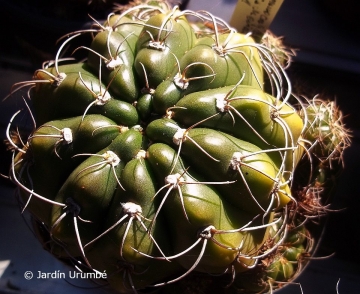
Gymnocalycium denudatum var. fleischerianum (Gymnocalycium paraguayense f. fleischerianum) Photo by: Alexander Arzberger
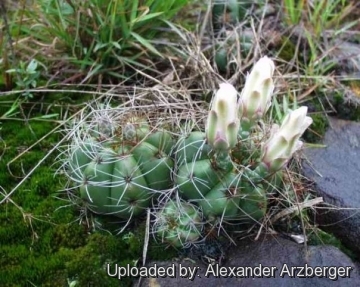
Gymnocalycium fleischerianum, AA 155, S Piribebuy, 132 m, Dep. Cordillera, Paraguay. (Gymnocalycium paraguayense f. fleischerianum) Photo by: Alexander Arzberger
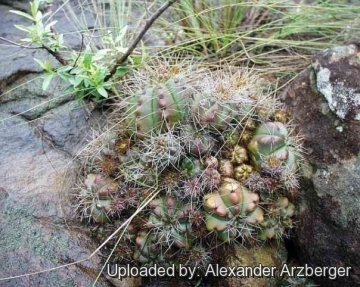
Gymnocalycium fleischerianum, AA 155, S Piribebuy, 132 m, Dep. Cordillera, Paraguay. (Gymnocalycium paraguayense f. fleischerianum) Photo by: Alexander Arzberger
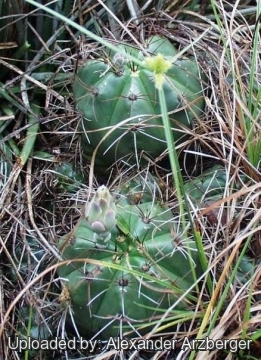
In habitat. (Gymnocalycium paraguayense f. fleischerianum) Photo by: Alexander Arzberger

Gymnocalycium denudatum var. fleischerianum (Gymnocalycium paraguayense f. fleischerianum) Photo by: Alexander Arzberger

Gymnocalycium denudatum var. fleischerianum (Gymnocalycium paraguayense f. fleischerianum) Photo by: Alexander Arzberger
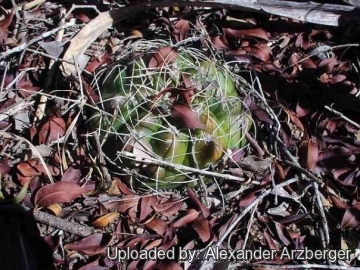
Gymnocalycium denudatum var. fleischerianum (Gymnocalycium paraguayense f. fleischerianum) Photo by: Alexander Arzberger
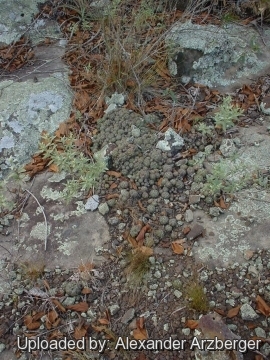
Gymnocalycium denudatum var. fleischerianum (Gymnocalycium paraguayense f. fleischerianum) Photo by: Alexander Arzberger
| Your Actions | |
|---|---|
| Back to Gymnocalycium index | |
| Back to Cactaceae index | |
 |
Back to Cacti Encyclopedia index |










